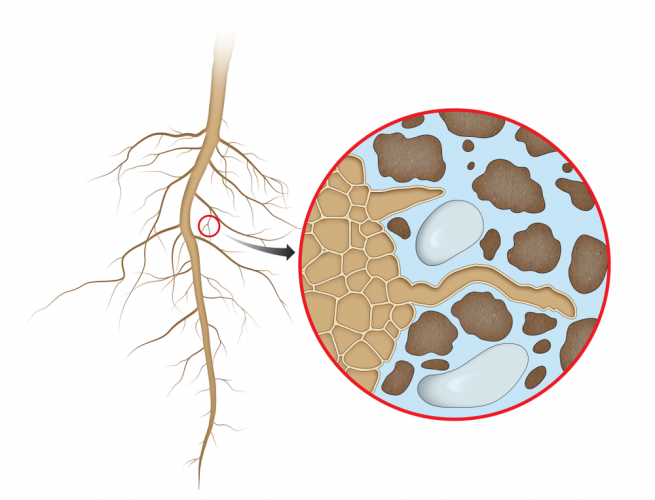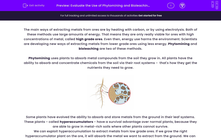The main ways of extracting metals from ores are by heating with carbon, or by using electrolysis. Both of these methods use large amounts of energy. That means they are only really viable for ores with high concentrations of metal, called high grade ores. Even then, energy use harms the environment. Scientists are developing new ways of extracting metals from lower grade ores using less energy. Phytomining and bioleaching are two of these methods.
Phytomining uses plants to absorb metal compounds from the soil they grow in. All plants have the ability to absorb and concentrate chemicals from the soil via their root systems - that's how they get the nutrients they need to grow.

Some plants have evolved the ability to absorb and store metals from the ground in their leaf systems. These plants - called hyperaccumulators - have a survival advantage over normal plants, because they are able to grow in metal-rich soils where other plants cannot survive.
We can exploit hyperaccumulation to extract metals from low grade ores. If we grow the right hyperaccumulator plant on the ore, it will absorb the metal we want to extract from the ground. We can collect the leaves from the plants - these will contain high concentrations of the metal we want. We typically burn the leaves, and use acid to extract the metals from the ash.
Compared with normal mining followed by heating with carbon or electrolysis, phytomining has several advantages:
The ore does not need to be mined and removed for processing.
Much less waste material is produced.
Most of the processing happens at lower temperatures, reducing energy use.
Phytomining can work well with lower grade ores, increasing the overall supply of metals.
However, phytomining is a slow process, and produces fairly small amounts of metal compared with conventional techniques.
Another way of using phytomining is to remove toxic metals from contaminated ground. If we grow hyperaccumulators on contaminated ground, they will remove the toxic substances from the soil, making it safe to use again.
Bioleaching uses bacteria, rather than plants, to remove metals from compounds. Some bacteria can extract energy from the chemical bonds in sulfate compounds, such as copper sulfate. When they do this, they produce a copper-rich solution, called a leachate. We can extract the copper from this with electrolysis or by a displacement reaction with scrap iron:
Cu2+(aq) + Fe(s) → Cu(s) + Fe2+(aq)
Like phytomining, bioleaching is a useful method for extracting metals from low-grade ores. This is particularly important for copper, where high-grade ores are increasingly rare. It also uses less energy than smelting. However, some of the chemicals produced in the process are harmful, and the process is relatively slow and expensive.
Now let's have a go at some questions on this.








